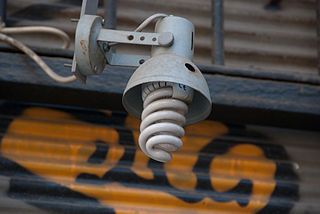From Guest Blogger Hannah Whittenly: If These Home Improvements Were Made Nationwide, We’d Have A Greener Economy

1. Change those light bulbs
Changing your light bulbs is the simplest and easiest home improvement project you can undertake. If you are still using incandescent light bulbs, replace them with compact fluorescent lamps (CFLs) or light-emitting diode (LED) lamps. By doing this you will still have the same amount of illumination but you will be using less energy.
If you run the three different bulbs (giving the same amount of light) for 3 hours a day, at the end of the year, a 60-watt incandescent bulb would have cost you $7.21 in electricity, an 800-lumen CFL would have cost you $1.56, and the 800-lumen LED would cost you $1.32.
2. Improve your insulation
A lot of money and energy is wasted when your home leaks cold air from your air conditioner or hot-air from your heater. Check for cracks and gaps in the exterior corners of your house, particularly where the bottom of your house and the foundation meet. Look for possible sources of air leakage around your doors, window frames, baseboards, attic hatches, vents, and wall-mounted air conditioners. Check the area where dryer vents pass through the walls, and where your cable and phone lines go through.
According to Retro Teck, windows are the biggest culprit for home energy loss: as much as 25-50% of heat could be retained in winter months with appropriate windows. Windows are so important to energy efficiency that both the US and Canadian governments offer sizable tax breaks to homeowners with qualifying home windows.
For this home improvement, you would only need some caulk and weather stripping, usually around windows, doorways, and air conditioners.
3. Attach aerators to your faucets and shower heads
Much of the water that flows out of faucets and shower heads goes to waste. By attaching an aerator to your faucets and shower heads, you will be able to determine the shape of the water streaming out and prevent unnecessary splashing. This tiny addition will make it possible for you to have the same power while using only half as much water. If homes all over the country used these, it could mean saving 250 million gallons of water per year.
4. Install a grey water diverter
If you use a lot of water for purposes other than cooking, drinking, bathing, and laundry, you could be using a lot more of this resource than is healthy for the planet. You would probably also be paying a hefty monthly water bill. Why don’t you install a grey-water diverter? Instead of allowing all of your wastewater to go to the sewer, this invention gathers water from your shower, your bath, wash basin, and laundry. It then filters and stores it so you can use it for your lawn and garden.
With this device, you save water, and you help reduce the energy used for bringing wastewater to the sewage treatment facility. This translates into reduced carbon dioxide emissions.
5. Install a high efficiency toilet
If your toilet has been in use since 1994 and it is using anywhere from three to seven gallons of water each time you flush, it is time to shift to a high efficiency toilet (HET). Today’s high-efficiency toilets use less than two gallons per super-efficient flush. This means a savings of at least 70 gallons of water daily for a family of four. Apart from what you save in terms of your water bill, in many places across the United States, you can get a rebate for replacing an old toilet with an HET.
None of these home improvements are prohibitively difficult or expensive, and all of them are practical. Applied by the 115 million plus households over the country, these micro changes would substantially change the way the country’s money is spent.

Hello Hannah, since renewable energy and journalism- getting a buzz going and people thinking and hopefully making the right moves for our environment are up your ally i thought you might find our project interesting. I live in Israel and we are number 2 (in the mean time) in cleantech innnovation.for example instead of conventional solar panels we have windows that produce energy and small panels that will replace chargers on phones or other appliances that can charge from any light source even a light bulb! (see 3gSolar company Jerusalem) or software that can save at least 30% of the energy used in large buildings, the list goes on. In addition we have a bit of a housing challenge now… so over a period of time i developed a project that, Bs”d, will both help provide affordable housing and accelarate clean tech development. The idea is to set up communities that will be off-grid (see Hamurabi-Stockholm model) and “green” along side a cleantech industrial park. I’d love to talk to you about it. please feel free to contact me
Florine Gabai